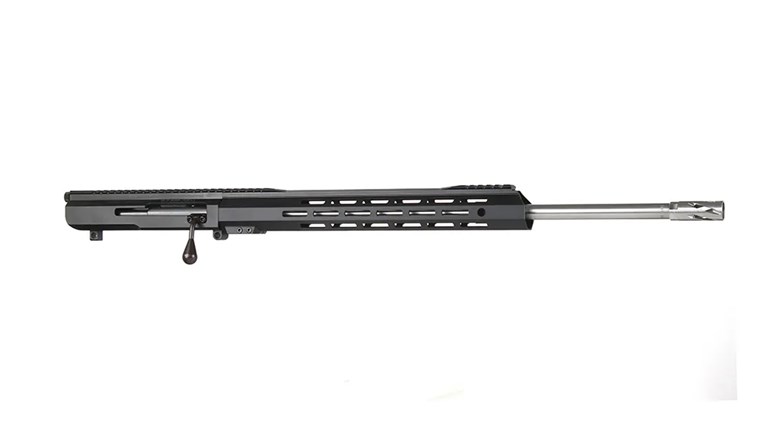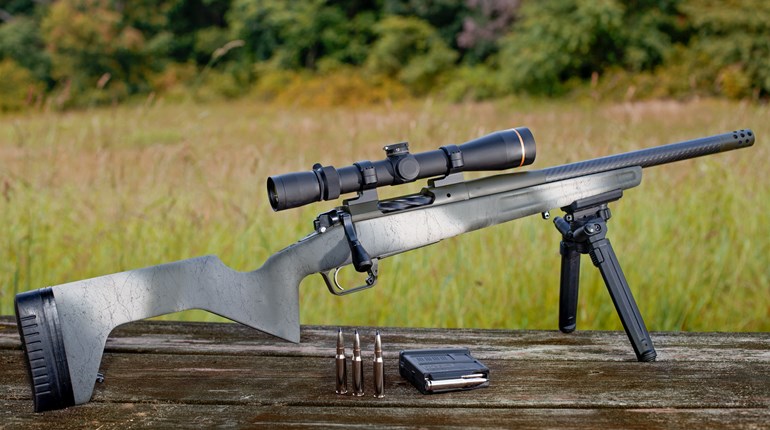
An officer responds to a domestic battery call that results in a hostage held at gunpoint, and there's no time for a SWAT team to respond. A rural sheriff's deputy encounters a hostile bear that has attacked a camper and needs to be put down. A bank-robbery suspect is in a shootout with officers whose handgun rounds can't penetrate his body armor. Each of these scenarios has made headlines at some point, and every one of them calls for a firearm beyond the capability of the typical handgun, carbine or shotgun carried by most officers. These are precisely the situations for which the Kimber Model 8400 Patrol rifle was created.
Every firearm has its advantages and limitations, and those included in the traditional law enforcement arsenal are no different. Handguns sacrifice power for mobility.Shotguns give up precision for versatility. Carbines often trade terminal performance for light weight and low recoil. While many agencies have long-range tactical rifles in their inventories, the high cost and significant training requirements associated with these tools limit widespread use. There is a niche to be filled in the law enforcement arsenal, and the Patrol seeks to fill that void.
A traditional bolt-action rifle chambered in .308 Win., the Patrol effectively bridges the gap between the M4-style carbine and the dedicated precision rifle. The 5.56 NATO is a great cartridge, but for bad guys wearing armor or using hard cover such as a vehicle, the .308 Win. has a clear advantage. At 8.5 pounds stripped and unloaded, the Patrol is quite a bit lighter than most precision bolt guns, and with a 20-inch barrel, it's more compact as well.
The Patrol is built on Kimber's 8400 action, which has proven itself reliable in the hunting fields—most notably in the Caprivi dangerous-game rifle—and is also used in the company's heavier, more expensive Advanced Tactical rifles. The 8400 design combines some of the most popular features of the world's great actions without being an exact facsimile of any of them.
At the heart of the action is a rotating bolt with dual-opposing locking lugs and a full-length, nonrotating claw extractor of the Mauser '98 style. The extractor grasps the rim of the cartridge during feeding and extraction, and ensures the rifle functions reliably, even when its operator is under stress. A fixed, blade-type ejector is another characteristic of the 8400 action, along with a bolt stop located at the 9-o'clock position on the side of the receiver. Unlike the Mauser, the 8400 uses a round action body. This makes the receiver easy to manufacture concentrically and bed into the stock, which translates to less-costly production. A separate recoil lug fits into a relief on the face of the receiver and is sandwiched in place by the barrel shank.

From the shooter's perspective, the Patrol is straightforward and simple to operate. An extended bolt handle with an enlarged knob combined with the controlled-round-feed action makes for smooth, fast cycling. The fluted bolt body may also be an aid in this department, though I suspect it's mostly cosmetic. A Model 70-style three-position safety on the bolt shroud allows the shooter to lock the bolt or to cycle the action with the safety engaged.
In contrast to many rifles intended for tactical use, the Patrol uses a traditional, fixed magazine with a hinged floorplate. I actually prefer the fixed magazine to detachable models for two reasons: It can't be lost, and it can be easily topped-off with single rounds inserted through the action port.
Unlike military rifles with Mauser-type extractors, a shooter can single-load the chamber of the Patrol to allow for a maximum capacity of 5+1 rounds. When I loaded the test rifle with five rounds, the bolt failed to strip the first cartridge from the magazine on a couple of instances out of the 150 or so rounds I fired. Apart from this slight mishap with the magazine, the rifle otherwise functioned perfectly.

One of the elements designed to make the Patrol attractive to law enforcement agencies is its relatively low cost. With this in mind, and instead of stepping down to a lower-quality injection-molded stock, Kimber chose to use a laminated wood stock painted with a matte-black, epoxy coating in lieu of an expensive, high-end synthetic unit. The stock is glass-bedded, free-floated and fitted with aluminum pillars. Laminates are very stable, and with the addition of the pillars, I would not hesitate to expose this stock to any of nature's elements.
From a design standpoint, the stock mimics the lines of Kimber's hunting rifles from the action rearward, but features a beavertail fore-end up front. Though I love the feel and angle of the rifle's grip and buttstock, I can't say the same for the fore-end. The beavertail is great for sandbags on the range or prone across a pack, but it's not ideal for many situations in the field, especially when shooting offhand. Its wide shape just feels awkward in my hand. As we've seen with the trend toward slim fore-ends on ARs, a trim stock makes a rifle faster and more natural to bring to bear. For times when the Patrol will be fired from a fixed position, such as resting the rifle across the hood or deck lid of a vehicle, the fore-end has an additional stud to accommodate a bipod.
The Patrol's 20-inch barrel is relatively heavy and made of what appears to be chrome-moly steel (Kimber does not disclose the exact composition of the metals used.) Fluting cuts a touch of weight and theoretically aids in cooling, and the recessed crown offers protection against damage to the muzzle. Since sustained firing in the law enforcement context for which the Patrol was designed is unlikely, Kimber could afford to make the barrel just a bit lighter to arrive at an even more mobile rifle.

Accuracy from the Patrol was good during testing, especially with match ammo. With 95 percent of police sniper shootings occurring at distances inside 100 yards according to data collected by the American Sniper Association, this need not be a .25-MOA rifle to be useful in the field. What is more important in a practical context is that the rifle's point-of-impact be consistent, and I found this to be the case with the Patrol throughout my testing.
Though the rifle shot slightly better with a clean barrel, it was a steady 1-inch gun with an 8.5X optic whether it was hot, cold or dirty. A 3.5-pound trigger pull made the rifle very shootable. I wouldn't want it to be much lighter, because the Patrol is designed to be a general-use rifle rather than a dedicated precision setup.
The Patrol isn't fitted with iron sights and makes no provision to mount them. This rifle is designed for use with an optic and comes fitted with a one-piece steel base, secured to the receiver using three large Torx-head screws. Because the rear section of the mount only features a single mounting slot, it is not compatible with all brands of "tactical" rings. After figuring this out the hard way, I used a set of 34 mm TPS Products rings from Brownells to secure a Bushnell SMRS 1-8.5x24 mm scope.
Though large, this versatile scope was a good match for the rifle. The wide field-of-view at 1X makes it extremely fast to use at close range, and 8.5X is plenty of magnification at the top-end for most situations where the Patrol would be employed. Bad things happen in low light, so the illuminated reticle would likely come in handy. (For a complete review of the Bushnell SMRS, see page 70.)

As a hunter, I'm very familiar with the handling qualities of a bolt-action design, and I found the Patrol to be easy to shoot rapidly at close and medium ranges, as well as capable of making precision shots at longer distances. With liability attached to every round an officer sends down the barrel, putting lots of bullets downrange usually isn't the proper way to solve a problem. The ability to place a .30-caliber rifle bullet with accuracy could be a fight-stopper in many scenarios, and this rifle is more than worthy of performing that important task.
A rifle designed to perform across a spectrum of applications is all about compromises. The Kimber Patrol is not as accurate as some $5,000 precision rifles, nor is it as good for clearing a house as an MP5, but it can perform in either role if an officer is faced with the need. With an MSRP of $1,495, it would likely be within the budget of many agencies to put a few Patrols on the street for situations when the scattergun or carbine isn't the right choice and a trained sniper isn't on the scene.
For civilians, the Patrol could pull triple-duty as a precision rifle for hunting, long-range target work and home defense, should the need for the power and penetration of the .308 Win. cartridge arise. The rifle's size, chambering and accuracy enhancements make it versatile, while its price makes it attractive.
Specifications
Manufacturer: Kimber; (888) 243-4522
Action Type: Bolt-action
Caliber: .308 Win.
Capacity: 5+1 rounds
Barrel: 20 inches; heavy-sporter contour
Rifling: 4 grooves; 1:12-inch RH twist
Sights: None; one-piece rail for optics
Trigger: Single-stage, adjustable; 3.5-pound pull weight
Stock: Laminated wood with epoxy finish
Length: 39.5 inches
Weight: 8 pounds, 8 ounces
MSRP: $1,495
Shooting Results
| Load | Velocity | Group Size | ||
| Smallest | Largest | Average | ||
| Federal American Eagle 150-grain FMJBT | 2,675 | 1.04 | 1.43 | 1.24 |
| Federal Premium Vital-Shok 150-grain Nosler Ballistic Tip | 2,754 | .81 | 1.44 | 1.06 |
| AYSM Precision 168-grain Sierra MatchKing BTHP | 2,514 | .65 | 1.30 | .87 |
Velocity measured in fps 10 feet from the muzzle for 10 consecutive shots with a Competitive Edge Dynamics M2 chronograph. Temperature: 66 degrees Fahrenheit. Accuracy measured in inches for five consecutive, five-shot groups at 100 yards from a bench rest.




































